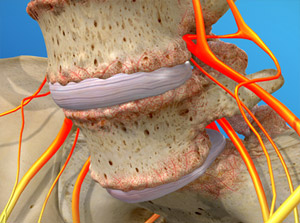What is spondylolisthesis?
Spondylolisthesis is a condition in which one vertebrae in your lower back or neck slips forward or backwards onto the next vertebrae. When the vertebrae slips out of place, it can put pressure on the nerves and spinal cord, causing back and/or excruciating leg pain.
The word spondylolisthesis comes from the Greek words:
Spondylos: means “spine” or “vertebrae”
Listhesis: means “slipping, sliding, or movement.”
Alphabet soup
Spondylolysis: pars defect or stress fracture in your spine
Spondylosis: spinal arthritis aka the ‘wear and tear’ of the spine
Spondylolisthesis: slippage of your vertebrae causing it to move forward or backwards
What causes spondylolisthesis?
There are many lots of different causes of spondylolisthesis. The main cause is actually from a condition that everyone will get as we age, called degenerative spondylolisthesis. This type is more common in people over 50 years old and usually occurs at the bottom levels of the spine (L3-4 and L4-5). L4-5 is the most common location.
Spondylolisthesis is sometimes thought of as a cascade. One anatomical change occurs, which leads to more degeneration and changes in your spines structure.
How? As we age, the discs in our spine begin to wear out. Because of this, the bones in the back of the spine (the facet joints) tend to overgrow leading to an unstable area which makes the vertebrae less able to stay in place. This abnormal slippage puts pressure and “pinches” the spinal nerves causing back or leg pain.
Additional causes can include
- Spondylolysis: this is a fracture in a bone of your vertebrae called your pars. When this fractures, it can lead to one vertebrae sliding forward or backwards onto another one.
- Congenital: means the disorder is present at birth
- Traumatic: meaning an injury or trauma causes the vertebrae to slip out of place. Athletes (especially those who perform a lot of hyperextension exercises such as football lineman) are more susceptible to this.
- Pathological: meaning another condition such as osteoporosis or cancer causes it to slip forward.
- Post surgical: meaning a vertebrae becomes unstable and slips forward after surgery which can weaken the bone that normally holds it stable.

What are symptoms of spondylolisthesis?
Symptoms of spondylolisthesis can vary from patient to patient and depends on where and what part of the spine has the slippage. Common symptoms include
- Lower back or leg pain
- Muscle tightness and stiffness
- Pain in your buttocks
- Pain that is worse with activity and made better with leaning forward or rest
How does Dr. Webb diagnose spondylolisthesis?
Spondylolisthesis is usually diagnosed by first taking your history and then performing a thorough physical exam. Dr. Webb will also order diagnostic xrays to see how much slippage of the vertebrae is occurring. The xrays will be taken with you bending forward and then bending backwards, called flexion-extension views. These additional xray veiws will help Dr. Webb determine how unstable your spine is.
What are the treatments for spondylosis?
Most patients can be treated without surgery with conservative treatment options. As the vertebrae continues to slide forwards or backwards, it can lead to compression of the nerves and spinal cord. The overall goal of Dr. Webb’s conservative treatment levels are to improve strength and coordination of the muscles that surround the spine. Fortunately, most patients respond favorably to levels I and II and do not require surgery.
Level I – Conservative treatments
- Non narcotic pain medications
- Non-Steroidal Anti-Inflammatories (NSAIDs)
- Oral Steroid Medications
- Physical Therapy, Chiropractic Therapy and/or Home Exercises
- Lifestyle Modification
- Traction
Level II Spinal Injections
- Epidural steroid injection: If your pain is in your legs and caused by compression of a spinal nerve, then Dr. Webb will recommend an epidural steroid injection. This is usually done with x-ray guidance and by a pain doctor.
Level III – Surgery
If conservative treatment options fail to relieve your pain, then surgery may then be recommended. This is reserved for those who fail to improve with levels I and II of conservative treatment and is directed at treating the abnormal movement of the spine. This is a structural problem and usually requires a fusion operation to stop the abnormal movement of the spine.
Anterior lumbar interbody fusion (ALIF)
- This is a procedure where a Vascular trained surgeon will assist Dr. Webb in going through your belly by making a small incision and accessing your spine from the front. Once at the spine, the diseased disc will be removed and replaced with either a plastic or metal cage to directly and indirectly decompress the spinal cord and nerves. Learn more about ALIFs
Extreme lateral interbody fusion (XLIF)
- This is a procedure where Dr. Webb will make a small incision on the side of your spine. Once at the spine, the diseased disc will be removed and replaced with either a plastic or metal cage to directly and indirectly decompress the spinal cord and nerves. Learn more about XLIFs here.
Transforaminal lumbar interbody fusion (TLIF)
- This is a procedure where Dr. Webb will make a small incision along your lower back and remove bone, ligament, soft tissue, and disc herniation that is compressing your spinal cord/nerves. Once at the spine, the diseased disc will be removed and replaced with either a plastic or metal cage to directly and indirectly decompress the spinal cord and nerves. Learn more about TLIFs
Posterior lumbar interbody fusion (PLIF)
- This is a procedure where Dr. Webb will make a small incision along your lower back and remove bone, ligament, soft tissue, and disc herniation that is compressing your spinal cord/nerves. Once at the spine, the diseased disc will be removed and replaced with either a plastic or metal cage to directly and indirectly decompress the spinal cord and nerves.
